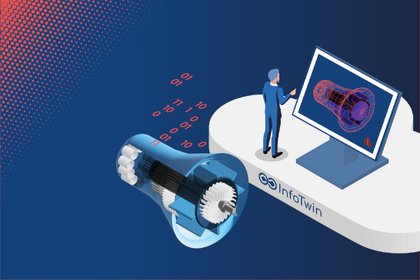Spare Parts Recognition Via Photo - Vision or Already Reality? Part 1
Both service technicians from machine, plant, vehicle or equipment manufacturing companies and maintenance technicians from operating companies are familiar with the following situation: A malfunction leads to a machine standstill that costs valuable production time and must be remedied as quickly as possible. The task now is to quickly identify and eliminate the cause of the malfunction.
One challenge often lies in identifying the right spare or wear part: Depending on the complexity of the machine or the size and wear of the spare part, this may not be easy. Misidentification leads to longer downtimes and thus to higher costs.
Three traditional ways to identify the right spare part
If the service technician or maintenance technician has access to an electronic spare parts catalog, the following options are usually available to him to identify the correct spare part as quickly as possible:
1. Manual navigation via the installation location:
Using the assembly structure of the spare parts catalog, the technician navigates to the correct subassembly based on the components of the machine and identifies the correct spare part. He is supported in this by the parts list with its entries for the individual components as well as meta information; if necessary, pictures or graphics are included in the spare parts catalog to provide further information.
2. Visual identification via 2D/3D graphics:
If the digital spare parts catalog contains 3D graphics of the machine, for example, the service technician has the option of finding the right spare part within the 3D model using visual recognition: He can rotate the 3D model, focus on it, show and hide individual parts, display them transparently - and thus take a virtual look inside the machine. The direct comparison of the three-dimensional representation of the individual components with reality simplifies the correct identification of the required part.
3. Identification via text search:
If the technician knows at least roughly which part is involved, the integrated text search of the spare parts catalog is a good option. Using the name of the spare part or meta information, such as the article number, the user can search for the required part in the entire catalog or in defined areas and order it directly online.
All three ways work well and lead to the goal but require the service technician or maintenance person to have in-depth knowledge of the structure, components, and individual parts of a machine. Is there a way to simplify this process and enable even easier identification of the spare part that requires less knowledge about the machine?
Our solution: Spare Part Identification by Photo
In simplified terms, the process of spare part recognition via photo looks like this:
- The service technician or maintenance technician takes a photo of the removed spare part with his smartphone or tablet.
- He transmits the photo digitally to a service that accesses a cloud-based, neural, trained network based on all relevant spare parts information from the manufacturer of the defective machine.
- The service uses AI technologies to determine which spare part could be the problem and plays the relevant results back to the service technician within a few seconds, indicating the probability of a match.
- The results are displayed directly in the digital spare parts catalog or service information system. By clicking on one of the results, the service technician jumps to the corresponding part in the spare parts catalog. Here he receives further information on the part, which is directly linked to relevant sections from the technical documentation and other content.
- With the additional information, the technician can now decide whether this is the spare part he needs or which of the results is the right one.
- The service technician can initiate an order directly via the digital spare parts catalog and find information about the installation process.
The benefits of Spare Part Identification by Photo
- Thanks to the simplified process, less knowledge is required from the service technician.
- He saves valuable time in identifying the required spare part. The first-time fix rate is increased, and customer satisfaction is enhanced.
- The hit probability indication provides information on the likelihood that the part is the correct one.
- The information from the spare parts catalog, which is directly linked to the respective results, helps to clearly identify the spare part.
- Incorrect orders are reduced.
- No special device and no special knowledge is required; a conventional smartphone or tablet with camera function is sufficient.
Does this all sound far too good to be true?
In part 2 of our blog series "Spare parts recognition via photo - vision or already reality?" we perform a reality check: Is spare parts recognition via photo only a vision so far or is it already a reality? What are the limitations and challenges and how can they be overcome?


